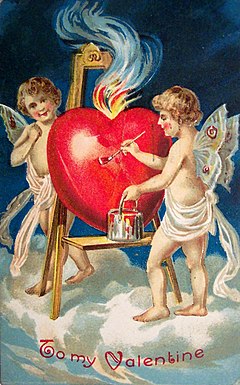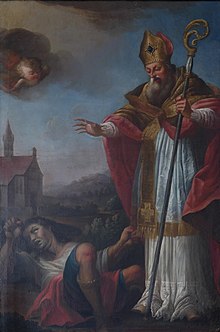
Back Valentynsdag Afrikaans Valentinstag ALS Hālgan Ualentines Dæg ANG عيد الحب Arabic عيد الحب ARZ ভেলেণ্টাইন দিৱস Assamese Día de San Valentín AST वेलेन्टाइन्स डे AWA Müqəddəs Valentin Günü Azerbaijani والنتاین گونو AZB
| Valentine's Day | |
|---|---|
 A Valentine's card, c. 1909 | |
| Also called | Saint Valentine's Day or the Feast of Saint Valentine |
| Observed by |
|
| Type | Christian, romantic, cultural, commercial observance |
| Significance | Feast day of Saint Valentine; the celebration of love and affection |
| Observances | Sending greeting cards and gifts, dating, church services, novenas |
| Date |
|
| Frequency | Annual |
| Part of a series on |
| Love |
|---|

Valentine's Day, also called Saint Valentine's Day or the Feast of Saint Valentine,[1] is celebrated annually on February 14.[2] It originated as a Christian feast day honoring a martyr named Valentine, and through later folk traditions it has also become a significant cultural, religious and commercial celebration of romance and love in many regions of the world.[3][4]
There are a number of martyrdom stories associated with various Saint Valentines connected to February 14,[5] including an account of the imprisonment of Saint Valentine of Rome for ministering to Christians persecuted under the Roman Empire in the third century.[6][7] According to an early tradition, Saint Valentine restored sight to the blind daughter of his jailer.[8] Numerous later additions to the legend have better related it to the theme of love: tradition maintains that Saint Valentine performed weddings for Christian soldiers who were forbidden to marry by the Roman emperor;[7] an 18th-century embellishment to the legend claims he wrote the jailer's daughter a letter signed "Your Valentine" as a farewell before his execution.[9]
The 8th-century Gelasian Sacramentary recorded the celebration of the Feast of Saint Valentine on February 14.[10][11] The day became associated with romantic love in the 14th and 15th centuries, when notions of courtly love flourished, apparently by association with the "lovebirds" of early spring. In 18th-century England, it grew into an occasion for couples to express their love for each other by presenting flowers, offering confectionery, and sending greeting cards (known as "valentines"). Valentine's Day symbols that are used today include the heart-shaped outline, doves, and the figure of the winged Cupid. In the 19th century, handmade cards gave way to mass-produced greetings.[12] In Italy, Saint Valentine's keys are given to lovers "as a romantic symbol and an invitation to unlock the giver's heart", as well as to children to ward off epilepsy (called Saint Valentine's Malady).[13]
Saint Valentine's Day is not a public holiday in any country, although it is an official feast day in the Anglican Communion[14] and the Lutheran Church.[15] Many parts of the Eastern Orthodox Church also celebrate Saint Valentine's Day on July 6 in honor of Roman presbyter Saint Valentine, and on July 30 in honor of Hieromartyr Valentine, the Bishop of Interamna (modern Terni).[16]
Cite error: There are <ref group=notes> tags on this page, but the references will not show without a {{reflist|group=notes}} template (see the help page).
- ^ Chambers 21st Century Dictionary, Revised ed., Allied Publishers, 2005, ISBN 9780550142108.
- ^ "Valentine's Day: Definition, History, & Traditions". Encyclopedia Britannica. Archived from the original on February 14, 2021. Retrieved February 14, 2021.
- ^ Kithcart, David (September 25, 2013). "St. Valentine, the Real Story". Christian Broadcasting Network. Archived from the original on February 15, 2021. Retrieved February 14, 2021.
- ^ Murphy, Stephen (February 14, 2022). "Love-seekers flock to St Valentine's resting place in Dublin for blessings". Sky News. Archived from the original on March 24, 2023. Retrieved March 7, 2023.
- ^ Ansgar, 1986, Chaucer and the Cult of Saint valentine, pp. 46–58.
- ^ Cooper, J.C. (October 23, 2013). Dictionary of Christianity. Routledge. p. 278. ISBN 9781134265466.
- ^ a b Chryssides, George D.; Wilkins, Margaret Z. (2014). Christians in the Twenty-First Century. Routledge. ISBN 978-1-317-54557-6.
The association between Valentine and lovers derives from a legend associated with Valentine of Rome. Emperor Claudius II wanted to recruit soldiers for the Roman army, and prohibited young men from marrying, in case homesickness for wives, homes and families should impair their military prowess. He also opposed the Christian faith, encouraging its persecution. Valentine, a physician priest, offered help to Christians whose lives were in peril and, although celibate himself, performed secret marriage rites for young men and women, defying the emperor's decree. He was discovered and imprisoned.
- ^ Ball, Ann (January 1, 1992). A Litany of Saints. OSV. ISBN 9780879734602.
- ^ Guiley, Rosemary (2001). The Encyclopedia of Saints. Infobase Publishing. p. 341. ISBN 9781438130262.
- ^ Schuster, Ildefonso (1927). The Sacramentary: (Liber Sacramentorum) : Historical & Liturgical Notes on the Roman Missal. Burns, Oates & Washbourne Ltd. p. 429.
VALENTINE, PRIEST AND MARTYR Station at the Cemetery of Valentine on the Via Flaminia. The festival of this martyr, who suffered during the persecution under the Emperor Claudius II, is to be found in the Gelasian Sacramentary. His sepulchral basilica on the Via Flaminia, built by Pope Julius I (341–52), and restored by Honorius I, was the first to greet the pilgrims as they approached the Eternal City, eagerly desirous of visiting the sepulchres of the ancient heroes of the Faith.
- ^ Polcar, P. (1894). "Gelasian Sacramentary 2.8–12". The Cult of Saints in Late Antiquity from its origins to circa AD 700, across the entire Christian world. Oxford University Press. Archived from the original on February 18, 2022. Retrieved February 18, 2022.
XVI Kal. Mart. in natali Valentini, Vitalis, et Feliculae. '14 February on the feast of Valentinus, Vitalis, and Felicula.' [*Valentinus, bishop of Terni (Interamna) and martyr of Rome, S00434; *Vitalis and Felicula, martyrs of Spoleto, *S01917] Three Prayers listed
- ^ Leigh Eric Schmidt, "The Fashioning of a Modern Holiday: St. Valentine's Day, 1840–1870" Winterthur Portfolio 28.4 (Winter 1993), pp. 209–245.
- ^ "St Valentine Key, Italy". Pitt Rivers Museum. University of Oxford. 2012. Archived from the original on July 19, 2014. Retrieved June 20, 2014.
- ^ "Holy Days". Church of England (Anglican Communion). 2012. Archived from the original on June 29, 2012. Retrieved October 27, 2012.
February 14 Valentine, Martyr at Rome, c.269
- ^ Pfatteicher, Philip H. (August 1, 2008). New Book of Festivals and Commemorations: A Proposed Common Calendar of Saints. Fortress Press. p. 86. ISBN 9780800621285. Archived from the original on January 1, 2014. Retrieved October 27, 2012.
- ^ Kyrou, Alexandros K. (February 14, 2015). "The Historical and Orthodox Saint Valentine". Greek Orthodox Archdiocese of America. Archived from the original on August 14, 2016. Retrieved February 12, 2016.
